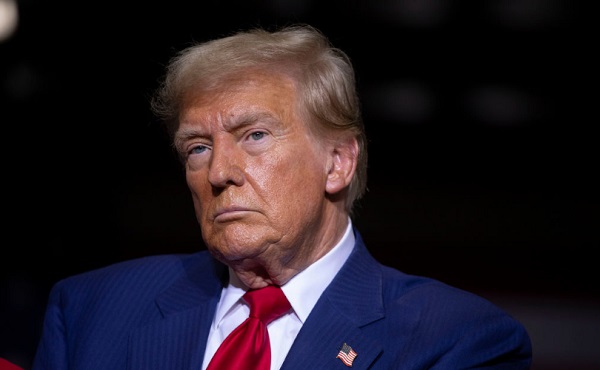Brownstone Institute
Trump’s 19th-Century Solution to Fiscal Disaster

From the Brownstone Institute
By
In the last weeks of the campaign, Donald Trump is slicing and dicing the Federal income tax nearly as fast as he served up fries at the McDonald’s drive-thru window last weekend. So far, he has proposed to extend the lower rates, family tax credits, and investment incentives of the 2017 Tax Act after they expire in 2025 and to also exempt tips, Social Security benefits, and overtime wages from the Federal income tax.
Those items alone would generate a revenue loss of $9 trillion over the next decade, but he has recently proposed to also exempt firefighters, police officers, military personnel, and veterans from the Federal income tax as well.
We estimate the latter would cost another $2.5 trillion in revenue loss over 10 years. As it happens, there are 370,000 firemen, 708,000 policemen, 2.86 million uniformed military personnel, and 18.0 million veterans in the US. These 22 million citizens have an estimated average income of $82,000 per year, which translates to about $60,000 each of AGI (adjusted gross income). At an average income tax rate of 14.7% these exclusions would generate $250 billion per year of reduced income tax payments.
In all, Trump has thus tossed out promises to cut income taxes by $11.5 trillion over the next 10-year budget window. In turn, these sweeping reductions would amount to upwards of 34% of CBO’s estimated baseline income tax revenue of $33.7 trillion over the period. Alas, even in the halcyon days of Reagan supply-side tax cutting no one really dreamed of eliminating fully one-third of the so-called crime of 1913 (the 16th Amendment which enabled the income tax).
10-Year Revenue Loss:
- Extend the 2017 Trump tax cuts: $5.350 trillion.
- Exempt overtime income: $2.000 trillion.
- End Taxation of Social Security benefits: $1.300 trillion.
- Exempt Tip income: $300 billion.
- Exempt Income of Firemen, Policemen, Military and Veterans: $2.500 trillion.
- Trump Total Revenue Loss: $11.500 trillion.
- CBO Income Tax Baseline Revenue: $33.700 trillion.
- Trump Revenue Loss As % of Baseline: 34%.
Then again, Trump may have something virtually epic in mind. To wit, scrapping the income tax entirely in favor of taxing consumption via levies on imported goods and merchandise.
“In the old days when we were smart, when we were a smart country, in the 1890s and all, this is when the country was relatively the richest it ever was. It had all tariffs. It didn’t have an income tax,” Trump said at a sit-down with voters in New York on Friday for Fox & Friends.
“Now we have income taxes, and we have people that are dying.”
The New York Times is deeply alarmed: “The former president has repeatedly praised a period in American history when there was no income tax, and the country relied on tariffs to fund the government.”
Actually, however, 19th-century America was even smarter than Trump realizes. In 1900 total Federal spending amounted to just 3.5% of GDP because back then America was still a peaceful republic and had no Warfare State or even significant standing army at all. And save for the most advanced precincts of Europe, the Welfare State hadn’t yet been invented, either.
So, yes, the so-called “revenue tariffs” of the 19th century did meet the income needs of the Federal government to the point of actually balancing the budget year after year between 1870 and 1900. Indeed, the actual annual surpluses were large enough to pay down most of the Civil War debt, to boot.
Today, of course, the Warfare State, Welfare State, and the Washington pork barrels account for 25% of GDP. So Trump may be directionally correct in wanting to tax consumption rather than income, but, as usual, he’s off by about seven orders of magnitude when it comes to the size of the Federal budget that needs to be financed.
Still, Trump has stepped up to the plate when it comes to a 21st-century version of the revenue tariff. He has pledged to impose a 20% universal tariff on all imports from all countries with a specific 60% rate for Chinese imports. Based on current US import levels of $3.5 trillion per year from worldwide sources and $450 billion from China, Trump’s tariffs would generate about $900 billion of receipts per annum.
To be sure, Trump’s claim that these giant tariffs would be paid for by Chinamen, Mexicans, and European socialists is just more of his standard baloney. Tariffs are paid for by consumers, but that’s actually the hidden virtue of the Tariff Man’s favorite word.
The truth is, government should be paid for via taxation on current citizens, not fobbed off in the form of giant debts on future citizens, born and unborn. So if we are going to have Big Government at 25% of GDP rather than a 19th-century government at 3.5% of GDP, and Trump is a Big Government Man if there ever was one, better that the burden be placed on consumption, not production, income, and investment.
After all, today the “makers” get hit good and hard by the current exceedingly lopsided income tax system. Thus, the top 1% pays 46% of income taxes, while the top 5% pays 66% and the top 10% pays 76% of all income taxes. On the other end, by contrast, the bottom 50% pays just 2.3% of individual income taxes, while 40% of all families pay no income tax at all.
In any event, the math works out such that the proposed Trumpian revenue tariffs would generate about $9 trillion over the next decade, or nearly 80% of the $11.5 trillion revenue loss from drastically shrinking the income tax coverage and collection rate. So that’s a big step in the direction of fiscal solvency rather than more UniParty free lunches.
To be sure, the proper redirection of Federal tax policy would be a national sales tax or VAT levy, which could be applied to both goods and services and to domestically produced output as well as to imports. Thus, a 5% VAT on the current $20 trillion per year of total PCE (personal consumption expenditures) would generate the equivalent of Trump’s revenue tariff, while a 15% levy on total PCE could replace both the Trump tariff and the remainder of the income tax entirely.
Notwithstanding its shortcomings, however, a revenue tariff is a long overdue start in the right direction. Trump’s bold stance in favor of taxing consumption rather than income and requiring all households to bear the cost of government, not just the small number of producers at the top of the economic ladder, is clearly superior to the status quo.
Still, this sweeping change in the composition and incidence of tax policy doesn’t really put the impending fiscal disaster to bed. Not by a long shot.
If you assume Trump’s big revenue tariffs and sweeping income tax cuts and that the other Federal payroll, corporate, and excise taxes remain the same, 10-year revenues compute to just $60 trillion versus built-in spending of $85 trillion per the CBO baseline. In short, even with a giant Trumpified version of the historical revenue tariff, Trump’s budget plan would still generate $25 trillion of red ink over the next decade.
10-Year Budget Outlook with Trump Tax Cuts and Tariffs, 2025 to 2034:
- Individual income taxes with Trump cuts: $22.0 trillion.
- Trump Revenue Tariffs: $9.0 trillion.
- Existing Payroll Taxes: $20.9 trillion.
- Existing Corporate Tax Ex-Trump Cut to 15% on Manufacturers: $4.6 trillion.
- Other Existing Federal Receipts: $3.5 trillion.
- Total Federal Revenue Under Trump Policy: $60.0 trillion.
- CBO Baseline Federal Outlays: $85.0 trillion.
- 10-Year Trump Deficit: $25.0 trillion.
To be sure, Trump has promised to turn Elon Musk loose on a crusade against government waste and inefficiency, and we say more power to him. If anyone has the courage and smarts to take on the Swamp, surely Elon Musk is at the top of the list.
Then again, Trump has promised to shield 82% of the budget from any cuts at all. That’s right. Elon could huff and puff and shrink the non-exempt programs and agencies by one-third and still leave deficits in excess of $20 trillion over the next decade.
10-year Cost Of Programs Trump Has Championed, Promised Not To Cut or Can’t Cut:
- Social Security: $20.0 trillion.
- Medicare: $16.0 trillion.
- Federal Military and Civilian Retirement Pensions: $2.5 trillion.
- Veterans’ programs: $3.0 trillion.
- National Security Budget: $15.5 trillion.
- Interest On the Public Debt: $13.0 trillion.
- Total Exempt Programs: $70.0 trillion.
- Exempt Programs As % of $85 trillion CBO Baseline: 82%.
In short, even with Trump’s full revenue tariffs and assuming Elon could actually slash 33% of the non-exempt budget without closing the Washington Monument, the bottom-line math leaves little to the imagination. Spending at $80 trillion would amount to 22.7% of GDP, while Trump’s tariff-heavy revenue package would generate $60 trillion of Federal receipts over the next decade, amounting to about 17.0% of GDP.
In turn, that would leave a structural deficit of nearly 6% of GDP as far as the eye can see. And that projection assumes no recession ever again and that interest on a public debt approaching $60 trillion by 2034 would average just 3.3% across the maturity spectrum.
We will take the unders on that proposition any day of the week and twice on Sunday. That is to say, CBO’s projection of $1.7 trillion of annual interest expense by 2034 is likely understated by several trillion. Per year.
In any event, the challenge of financing these giant deficits along with $900 billion per year of Trump tariffs would be considerable. The latter alone would amount to nearly 10% of annual US consumption of consumer goods and fixed investment goods.
So if the Fed were to “accommodate” these massive Trump tariffs by running the printing presses red-hot in an attempt to compensate for lost household purchasing power, it could well trigger a burst of inflation even more virulent than that of 2021-2024.
On the other hand, were it to adhere to the correct sound money solution and refuse to “accommodate” both the massive Trump deficits and the giant Trump tariffs, bond yields, and interest rates would soar, even as the Main Street economy contracted sharply in response to a one-time 10% increase in the general price level.
Financing massive budget deficits honestly in the bond pits rather than at the Fed’s printing presses would also unleash the mother of all meltdowns in today’s insanely inflated financial markets. Trump would therefore get his tariff and some substantial reshoring of industrial production, but also a hair-curling recession on Main Street and a Bronx Cheer from the canyons of Wall Street.
Unfortunately, that’s the price America would have to pay even under Trumpian economics to purge the destructive effects of decades of UniParty spend, borrow, and print policies.
Still, we can actually think of a decidedly worse scenario. To wit, perpetuation of the UniParty status quo, which is what we would get from the Washington ruling party that replaced a failing mind in the Oval Office with an empty one on the Democratic presidential ticket.
A version of this piece appeared on the author’s site.
Brownstone Institute
The Unmasking of Vaccine Science

From the Brownstone Institute
By
I recently purchased Aaron Siri’s new book Vaccines, Amen. As I flipped though the pages, I noticed a section devoted to his now-famous deposition of Dr Stanley Plotkin, the “godfather” of vaccines.
I’d seen viral clips circulating on social media, but I had never taken the time to read the full transcript — until now.
Siri’s interrogation was methodical and unflinching…a masterclass in extracting uncomfortable truths.
A Legal Showdown
In January 2018, Dr Stanley Plotkin, a towering figure in immunology and co-developer of the rubella vaccine, was deposed under oath in Pennsylvania by attorney Aaron Siri.
The case stemmed from a custody dispute in Michigan, where divorced parents disagreed over whether their daughter should be vaccinated. Plotkin had agreed to testify in support of vaccination on behalf of the father.
What followed over the next nine hours, captured in a 400-page transcript, was extraordinary.
Plotkin’s testimony revealed ethical blind spots, scientific hubris, and a troubling indifference to vaccine safety data.
He mocked religious objectors, defended experiments on mentally disabled children, and dismissed glaring weaknesses in vaccine surveillance systems.
A System Built on Conflicts
From the outset, Plotkin admitted to a web of industry entanglements.
He confirmed receiving payments from Merck, Sanofi, GSK, Pfizer, and several biotech firms. These were not occasional consultancies but long-standing financial relationships with the very manufacturers of the vaccines he promoted.
Plotkin appeared taken aback when Siri questioned his financial windfall from royalties on products like RotaTeq, and expressed surprise at the “tone” of the deposition.
Siri pressed on: “You didn’t anticipate that your financial dealings with those companies would be relevant?”
Plotkin replied: “I guess, no, I did not perceive that that was relevant to my opinion as to whether a child should receive vaccines.”
The man entrusted with shaping national vaccine policy had a direct financial stake in its expansion, yet he brushed it aside as irrelevant.
Contempt for Religious Dissent
Siri questioned Plotkin on his past statements, including one in which he described vaccine critics as “religious zealots who believe that the will of God includes death and disease.”
Siri asked whether he stood by that statement. Plotkin replied emphatically, “I absolutely do.”
Plotkin was not interested in ethical pluralism or accommodating divergent moral frameworks. For him, public health was a war, and religious objectors were the enemy.
He also admitted to using human foetal cells in vaccine production — specifically WI-38, a cell line derived from an aborted foetus at three months’ gestation.
Siri asked if Plotkin had authored papers involving dozens of abortions for tissue collection. Plotkin shrugged: “I don’t remember the exact number…but quite a few.”
Plotkin regarded this as a scientific necessity, though for many people — including Catholics and Orthodox Jews — it remains a profound moral concern.
Rather than acknowledging such sensitivities, Plotkin dismissed them outright, rejecting the idea that faith-based values should influence public health policy.
That kind of absolutism, where scientific aims override moral boundaries, has since drawn criticism from ethicists and public health leaders alike.
As NIH director Jay Bhattacharya later observed during his 2025 Senate confirmation hearing, such absolutism erodes trust.
“In public health, we need to make sure the products of science are ethically acceptable to everybody,” he said. “Having alternatives that are not ethically conflicted with foetal cell lines is not just an ethical issue — it’s a public health issue.”
Safety Assumed, Not Proven
When the discussion turned to safety, Siri asked, “Are you aware of any study that compares vaccinated children to completely unvaccinated children?”
Plotkin replied that he was “not aware of well-controlled studies.”
Asked why no placebo-controlled trials had been conducted on routine childhood vaccines such as hepatitis B, Plotkin said such trials would be “ethically difficult.”
That rationale, Siri noted, creates a scientific blind spot. If trials are deemed too unethical to conduct, then gold-standard safety data — the kind required for other pharmaceuticals — simply do not exist for the full childhood vaccine schedule.
Siri pointed to one example: Merck’s hepatitis B vaccine, administered to newborns. The company had only monitored participants for adverse events for five days after injection.
Plotkin didn’t dispute it. “Five days is certainly short for follow-up,” he admitted, but claimed that “most serious events” would occur within that time frame.
Siri challenged the idea that such a narrow window could capture meaningful safety data — especially when autoimmune or neurodevelopmental effects could take weeks or months to emerge.
Siri pushed on. He asked Plotkin if the DTaP and Tdap vaccines — for diphtheria, tetanus and pertussis — could cause autism.
“I feel confident they do not,” Plotkin replied.
But when shown the Institute of Medicine’s 2011 report, which found the evidence “inadequate to accept or reject” a causal link between DTaP and autism, Plotkin countered, “Yes, but the point is that there were no studies showing that it does cause autism.”
In that moment, Plotkin embraced a fallacy: treating the absence of evidence as evidence of absence.
“You’re making assumptions, Dr Plotkin,” Siri challenged. “It would be a bit premature to make the unequivocal, sweeping statement that vaccines do not cause autism, correct?”
Plotkin relented. “As a scientist, I would say that I do not have evidence one way or the other.”
The MMR
The deposition also exposed the fragile foundations of the measles, mumps, and rubella (MMR) vaccine.
When Siri asked for evidence of randomised, placebo-controlled trials conducted before MMR’s licensing, Plotkin pushed back: “To say that it hasn’t been tested is absolute nonsense,” he said, claiming it had been studied “extensively.”
Pressed to cite a specific trial, Plotkin couldn’t name one. Instead, he gestured to his own 1,800-page textbook: “You can find them in this book, if you wish.”
Siri replied that he wanted an actual peer-reviewed study, not a reference to Plotkin’s own book. “So you’re not willing to provide them?” he asked. “You want us to just take your word for it?”
Plotkin became visibly frustrated.
Eventually, he conceded there wasn’t a single randomised, placebo-controlled trial. “I don’t remember there being a control group for the studies, I’m recalling,” he said.
The exchange foreshadowed a broader shift in public discourse, highlighting long-standing concerns that some combination vaccines were effectively grandfathered into the schedule without adequate safety testing.
In September this year, President Trump called for the MMR vaccine to be broken up into three separate injections.
The proposal echoed a view that Andrew Wakefield had voiced decades earlier — namely, that combining all three viruses into a single shot might pose greater risk than spacing them out.
Wakefield was vilified and struck from the medical register. But now, that same question — once branded as dangerous misinformation — is set to be re-examined by the CDC’s new vaccine advisory committee, chaired by Martin Kulldorff.
The Aluminium Adjuvant Blind Spot
Siri next turned to aluminium adjuvants — the immune-activating agents used in many childhood vaccines.
When asked whether studies had compared animals injected with aluminium to those given saline, Plotkin conceded that research on their safety was limited.
Siri pressed further, asking if aluminium injected into the body could travel to the brain. Plotkin replied, “I have not seen such studies, no, or not read such studies.”
When presented with a series of papers showing that aluminium can migrate to the brain, Plotkin admitted he had not studied the issue himself, acknowledging that there were experiments “suggesting that that is possible.”
Asked whether aluminium might disrupt neurological development in children, Plotkin stated, “I’m not aware that there is evidence that aluminum disrupts the developmental processes in susceptible children.”
Taken together, these exchanges revealed a striking gap in the evidence base.
Compounds such as aluminium hydroxide and aluminium phosphate have been injected into babies for decades, yet no rigorous studies have ever evaluated their neurotoxicity against an inert placebo.
This issue returned to the spotlight in September 2025, when President Trump pledged to remove aluminium from vaccines, and world-leading researcher Dr Christopher Exley renewed calls for its complete reassessment.
A Broken Safety Net
Siri then turned to the reliability of the Vaccine Adverse Event Reporting System (VAERS) — the primary mechanism for collecting reports of vaccine-related injuries in the United States.
Did Plotkin believe most adverse events were captured in this database?
“I think…probably most are reported,” he replied.
But Siri showed him a government-commissioned study by Harvard Pilgrim, which found that fewer than 1% of vaccine adverse events are reported to VAERS.
“Yes,” Plotkin said, backtracking. “I don’t really put much faith into the VAERS system…”
Yet this is the same database officials routinely cite to claim that “vaccines are safe.”
Ironically, Plotkin himself recently co-authored a provocative editorial in the New England Journal of Medicine, conceding that vaccine safety monitoring remains grossly “inadequate.”
Experimenting on the Vulnerable
Perhaps the most chilling part of the deposition concerned Plotkin’s history of human experimentation.
“Have you ever used orphans to study an experimental vaccine?” Siri asked.
“Yes,” Plotkin replied.
“Have you ever used the mentally handicapped to study an experimental vaccine?” Siri asked.
“I don’t recollect…I wouldn’t deny that I may have done so,” Plotkin replied.
Siri cited a study conducted by Plotkin in which he had administered experimental rubella vaccines to institutionalised children who were “mentally retarded.”
Plotkin stated flippantly, “Okay well, in that case…that’s what I did.”
There was no apology, no sign of ethical reflection — just matter-of-fact acceptance.
Siri wasn’t done.
He asked if Plotkin had argued that it was better to test on those “who are human in form but not in social potential” rather than on healthy children.
Plotkin admitted to writing it.
Siri established that Plotkin had also conducted vaccine research on the babies of imprisoned mothers, and on colonised African populations.
Plotkin appeared to suggest that the scientific value of such studies outweighed the ethical lapses—an attitude that many would interpret as the classic ‘ends justify the means’ rationale.
But that logic fails the most basic test of informed consent. Siri asked whether consent had been obtained in these cases.
“I don’t remember…but I assume it was,” Plotkin said.
Assume?
This was post-Nuremberg research. And the leading vaccine developer in America couldn’t say for sure whether he had properly informed the people he experimented on.
In any other field of medicine, such lapses would be disqualifying.
A Casual Dismissal of Parental Rights
Plotkin’s indifference to experimenting on disabled children didn’t stop there.
Siri asked whether someone who declined a vaccine due to concerns about missing safety data should be labelled “anti-vax.”
Plotkin replied, “If they refused to be vaccinated themselves or refused to have their children vaccinated, I would call them an anti-vaccination person, yes.”
Plotkin was less concerned about adults making that choice for themselves, but he had no tolerance for parents making those choices for their own children.
“The situation for children is quite different,” said Plotkin, “because one is making a decision for somebody else and also making a decision that has important implications for public health.”
In Plotkin’s view, the state held greater authority than parents over a child’s medical decisions — even when the science was uncertain.
The Enabling of Figures Like Plotkin
The Plotkin deposition stands as a case study in how conflicts of interest, ideology, and deference to authority have corroded the scientific foundations of public health.
Plotkin is no fringe figure. He is celebrated, honoured, and revered. Yet he promotes vaccines that have never undergone true placebo-controlled testing, shrugs off the failures of post-market surveillance, and admits to experimenting on vulnerable populations.
This is not conjecture or conspiracy — it is sworn testimony from the man who helped build the modern vaccine program.
Now, as Health Secretary Robert F. Kennedy, Jr. reopens long-dismissed questions about aluminium adjuvants and the absence of long-term safety studies, Plotkin’s once-untouchable legacy is beginning to fray.
Republished from the author’s Substack
Brownstone Institute
Bizarre Decisions about Nicotine Pouches Lead to the Wrong Products on Shelves

From the Brownstone Institute
A walk through a dozen convenience stores in Montgomery County, Pennsylvania, says a lot about how US nicotine policy actually works. Only about one in eight nicotine-pouch products for sale is legal. The rest are unauthorized—but they’re not all the same. Some are brightly branded, with uncertain ingredients, not approved by any Western regulator, and clearly aimed at impulse buyers. Others—like Sweden’s NOAT—are the opposite: muted, well-made, adult-oriented, and already approved for sale in Europe.
Yet in the United States, NOAT has been told to stop selling. In September 2025, the Food and Drug Administration (FDA) issued the company a warning letter for offering nicotine pouches without marketing authorization. That might make sense if the products were dangerous, but they appear to be among the safest on the market: mild flavors, low nicotine levels, and recyclable paper packaging. In Europe, regulators consider them acceptable. In America, they’re banned. The decision looks, at best, strange—and possibly arbitrary.
What the Market Shows
My October 2025 audit was straightforward. I visited twelve stores and recorded every distinct pouch product visible for sale at the counter. If the item matched one of the twenty ZYN products that the FDA authorized in January, it was counted as legal. Everything else was counted as illegal.
Two of the stores told me they had recently received FDA letters and had already removed most illegal stock. The other ten stores were still dominated by unauthorized products—more than 93 percent of what was on display. Across all twelve locations, about 12 percent of products were legal ZYN, and about 88 percent were not.
The illegal share wasn’t uniform. Many of the unauthorized products were clearly high-nicotine imports with flashy names like Loop, Velo, and Zimo. These products may be fine, but some are probably high in contaminants, and a few often with very high nicotine levels. Others were subdued, plainly meant for adult users. NOAT was a good example of that second group: simple packaging, oat-based filler, restrained flavoring, and branding that makes no effort to look “cool.” It’s the kind of product any regulator serious about harm reduction would welcome.
Enforcement Works
To the FDA’s credit, enforcement does make a difference. The two stores that received official letters quickly pulled their illegal stock. That mirrors the agency’s broader efforts this year: new import alerts to detain unauthorized tobacco products at the border (see also Import Alert 98-06), and hundreds of warning letters to retailers, importers, and distributors.
But effective enforcement can’t solve a supply problem. The list of legal nicotine-pouch products is still extremely short—only a narrow range of ZYN items. Adults who want more variety, or stores that want to meet that demand, inevitably turn to gray-market suppliers. The more limited the legal catalog, the more the illegal market thrives.
Why the NOAT Decision Appears Bizarre
The FDA’s own actions make the situation hard to explain. In January 2025, it authorized twenty ZYN products after finding that they contained far fewer harmful chemicals than cigarettes and could help adult smokers switch. That was progress. But nine months later, the FDA has approved nothing else—while sending a warning letter to NOAT, arguably the least youth-oriented pouch line in the world.
The outcome is bad for legal sellers and public health. ZYN is legal; a handful of clearly risky, high-nicotine imports continue to circulate; and a mild, adult-market brand that meets European safety and labeling rules is banned. Officially, NOAT’s problem is procedural—it lacks a marketing order. But in practical terms, the FDA is punishing the very design choices it claims to value: simplicity, low appeal to minors, and clean ingredients.
This approach also ignores the differences in actual risk. Studies consistently show that nicotine pouches have far fewer toxins than cigarettes and far less variability than many vapes. The biggest pouch concerns are uneven nicotine levels and occasional traces of tobacco-specific nitrosamines, depending on manufacturing quality. The serious contamination issues—heavy metals and inconsistent dosage—belong mostly to disposable vapes, particularly the flood of unregulated imports from China. Treating all “unauthorized” products as equally bad blurs those distinctions and undermines proportional enforcement.
A Better Balance: Enforce Upstream, Widen the Legal Path
My small Montgomery County survey suggests a simple formula for improvement.
First, keep enforcement targeted and focused on suppliers, not just clerks. Warning letters clearly change behavior at the store level, but the biggest impact will come from auditing distributors and importers, and stopping bad shipments before they reach retail shelves.
Second, make compliance easy. A single-page list of authorized nicotine-pouch products—currently the twenty approved ZYN items—should be posted in every store and attached to distributor invoices. Point-of-sale systems can block barcodes for anything not on the list, and retailers could affirm, once a year, that they stock only approved items.
Third, widen the legal lane. The FDA launched a pilot program in September 2025 to speed review of new pouch applications. That program should spell out exactly what evidence is needed—chemical data, toxicology, nicotine release rates, and behavioral studies—and make timely decisions. If products like NOAT meet those standards, they should be authorized quickly. Legal competition among adult-oriented brands will crowd out the sketchy imports far faster than enforcement alone.
The Bottom Line
Enforcement matters, and the data show it works—where it happens. But the legal market is too narrow to protect consumers or encourage innovation. The current regime leaves a few ZYN products as lonely legal islands in a sea of gray-market pouches that range from sensible to reckless.
The FDA’s treatment of NOAT stands out as a case study in inconsistency: a quiet, adult-focused brand approved in Europe yet effectively banned in the US, while flashier and riskier options continue to slip through. That’s not a public-health victory; it’s a missed opportunity.
If the goal is to help adult smokers move to lower-risk products while keeping youth use low, the path forward is clear: enforce smartly, make compliance easy, and give good products a fair shot. Right now, we’re doing the first part well—but failing at the second and third. It’s time to fix that.
-

 Crime11 hours ago
Crime11 hours agoTerror in Australia: 12 killed after gunmen open fire on Hanukkah celebration
-

 Energy2 days ago
Energy2 days agoCanada’s future prosperity runs through the northwest coast
-

 Crime11 hours ago
Crime11 hours agoHero bystander disarms shooter in Australian terror attack
-

 Business18 hours ago
Business18 hours agoInflation Reduction Act, Green New Deal Causing America’s Energy Crisis
-

 Business1 day ago
Business1 day agoFuelled by federalism—America’s economically freest states come out on top
-

 illegal immigration1 day ago
illegal immigration1 day agoUS Notes 2.5 million illegals out and counting
-

 Daily Caller1 day ago
Daily Caller1 day ago‘There Will Be Very Serious Retaliation’: Two American Servicemen, Interpreter Killed In Syrian Attack
-

 Automotive1 day ago
Automotive1 day agoPoliticians should be honest about environmental pros and cons of electric vehicles







